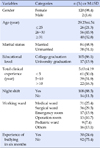Abstract
Purpose
The purpose of this study was to identify relationships among self-esteem, social support, nursing organizational culture, experience of workplace bullying, and the consequences of workplace bullying in hospital nurses, and then to provide basic information for developing workplace bullying prevention programs.
Methods
Participants were 122 hospital nurses from three general hospitals. Data collection was done during April and May 2015. Data were collected using self-report questionnaires which were used to identify participants' characteristics, self-esteem, social support, nursing organizational culture, and workplace bullying.
Figures and Tables
Table 2
Degree of Self-esteem, Social Support, Nursing Organization Culture, and Workplace Bullying in Nursing (N=122)

Table 3
Differences of Workplace Bullying in Nursing Consequence Inventory by General and Work-related Characteristics of Participants (N=122)

References
1. Hubert AB, van Veldhoven M. Risk sectors for undesirable behaviour and mobbing. Eur J Work Organ Psychol. 2001; 10(4):415–424. DOI: 10.1080/13594320143000799.
2. Lewis MA. Nurse bullying: organizational considerations in the maintenance and perpetration of health care bullying cultures. J Nurs Manag. 2006; 14:52–58. DOI: 10.1111/j.1365-2934.2005.00535.x.
3. Lee Y, Lee M, Bernstein K. Effect of workplace bullying and job stress on turnover intention in hospital nurses. J Korean Acad Psychiatr Ment Health Nurs. 2013; 22(2):77–87. DOI: 10.12934/jkpmhn.2013.22.2.77.
4. Seo YN. The role of culture on workplace bullying: The comparison between UK and South Korea[Ph.D dissertation]. Nottinghamshire county: University of Nottingham;2010.
5. Johnson SL, Rea RE. Workplace bullying: Concerns for nurse leaders. J Nurs Adm. 2009; 39(2):84–90. DOI: 10.1097/NNA.0b013e318195a5fc.
6. Simons S. Workplace bullying experienced by Massachusetts registered nurses and the relationship to intention to leave the organization. ANS Adv Nurs Sci. 2008; 31(2):E48–E59. DOI: 10.1097/01.ANS.0000319571.37373.d7.
7. Stanley KM, Martin MM, Nemeth LS, Michel Y, Welton JM. Examining lateral violence in the nursing workforce. Issues Ment Health Nurs. 2007; 28:1247–1265. DOI: 10.1080/01612840701651470.
8. Lutgen-Sandvik P, Tracy SJ, Alberts JK. Burned by bullying in the American workplace: Prevalence, perception, degree and impact. J Manag Stud. 2007; 44(6):837–862. DOI: 10.1111/j.1467-6486.2007.00715.x.
9. Royal College of Nursing. Healthy workplace, healthy you. Bullying and harassment at work: A guide for RCN members. cited 2016 January 15. Available from: https://www2.rcn.org.uk/__data/assets/pdf_file/0011/78518/001497.pdf.
10. Cleary M, Hunt GE, Horfall J. Identifying and addressing bullying in nursing. Issues Ment Health Nurs. 2010; 31(5):331–335. DOI: 10.3109/01612840903308531.
11. Johnson SL. International perspectives on workplace bullying among nurses: A review. Int Nurs Rev. 2009; 56(1):34–40. DOI: 10.1111/j.1466-7657.2008.00679.x.
12. Hutchinson M, Wilkes L, Jackson D, Vickers MH. Integrating individual, work group and organizational factors: Testing a multidimensional model of bullying in the nursing workplace. J Nurs Manag. 2010; 18(2):173–181. DOI: 10.1111/j.1365-2834.2009.01035.x.
13. Rosenberg M. Society and adolescent self-image. Princeton: Princeton University Press;1965.
14. Cohen S, Wills TA. Stress, social support, and the buffering hypothesis. Psychol Bull. 1985; 98:310–357.
15. Baillien E, De Witte H. Why is organizational change related to workplace bullying? Role conflict and job insecurity as mediators. Econ Ind Democr. 2009; 30:348–371. DOI: 10.1177/0143831X09336557.
16. Hogh A, Hoel H, Carneiro . IG. Bullying and employee turnover among healthcare workers: A three-wave prospective study. J Nurs Manag. 2011; 19(6):742–751. DOI: 10.1111/j.1365-2834.2011.01264.x.
17. Kim M, Han S, Kim J. The development of the nursing organization culture measurement tool. J Korean Acad Nurs Adm. 2004; 10(2):175–184.
18. Samnani AK, Singh P. 20 Years of workplace bullying research: a review of the antecedents and consequences of bullying in the workplace. Aggress Violent Behav. 2012; 17:581–589. DOI: 10.1016/j.avb.2012.08.004.
19. Hutchinson M, Vickers M, Jackson D, Wilkes L. Workplace bulling in nursing: Towards a more critical organizational perspective. Nurs Inq. 2006; 13:118–126. DOI: 10.1111/j.1440-1800.2006.00314.x.
20. Yun S, Kang J. Factors affecting workplace bullying in Korean hospital nurses. Korean J Adult Nurs. 2014; 26(5):553–562. DOI: 10.7475/kjan.2014.26.5.553.
21. Australian Institute of Employment Rights. Workplace culture and bullying. cited 2016 May 28. Available from: http://www.aph.gov.au/Parliamentary_Business/Committees/House_of_representatives_Committees?url=ee/bullying/subs/sub109.pdf.
22. Lee Y, Lee M. Development and validity of workplace bullying in nursing-type inventory(WPBN-TI). J Korean Acad Nurs. 2014; 44(2):209–218. DOI: 10.4040/jkan.2014.44.2.209.
23. Lee Y. The conceptual development and development of new instruments to measure bullying in nursing workplace [dissertation]. Incheon: Inha University;2014.
24. Weinert C, Brandt PA. Measuring social support with the personal resource questionnaire. West J Nurs Res. 1987; 9(4):589–602. DOI: 10.1177/019394598700900411.
25. Tak YR, Kim SA, Lee BS. Perceived social support, instrumental support needs, and depression of elderly women. Korean J Women Health Nurs. 2003; 9(4):449–456.
26. Kang HY. The relationship among nurses' workplace bullying, organizational commitment and turnover intention[Master thesis]. Seoul: Yonsei University;2015.
27. Choi SE, Lee SS, Kim SD. Relationships of workplace bullying to self-esteem and turnover intention among clinical nurses at small and medium-sized hospitals. Korean J Occup Health Nurs. 2013; 22(4):267–274. DOI: 10.5807/kjohn.2013.22.4.267.
28. Park BY, Lee KH, Shin JH. Relationship between verbal abuse and mental health in some operating nurses. J Korea Inst Electron Commun Sci. 2012; 7(5):1205–1211.
29. Tambur M, Vadi M. Workplace bullying and organizational culture in a post-transitional country. Int J Manpow. 2012; 33(7):754–768. DOI: 10.1108/01437721211268302.
30. Hutchinson M, Hurley J. Exploring leadership capability and emotional intelligence as moderators of workplace bullying. J Nurs Manag. 2013; 21(3):553–562. DOI: 10.1111/j.1365-2834.2012.01372.x.




 PDF
PDF ePub
ePub Citation
Citation Print
Print





 XML Download
XML Download